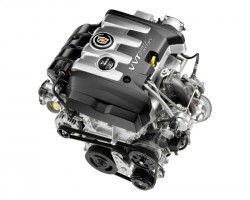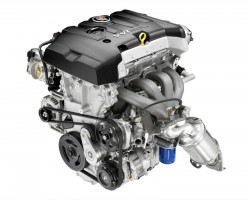ATS Powertrains
Image Gallery of the new ATS
 One of the biggest stories of the ATS are its 3 powertrains. In addition to Cadillac's trademark 3.6l V-6, the ATS also sees the introduction of a pair of 4-cylinder powertrains to a brand that is known more for its V-8s than for products with half that number of cylinders.
However, in the modern luxury market, a good 4-cylinder is becoming much more common. Audi's A4 is 4-cylinder exclusive and BMW's 3-Series - often synonymous for its straight-6 engines, is now offering a 4-cylinder as its entry engine.
These are not penalty-box engines Cadillac is putting into its ATS. The 2.5 is brand new, the 2.0 is claimed to be all-new as well - though a 2.0 turbo, DI 4 has been seen in a few products from GM over the past few years...though not with every feature of the ATS' engine. The 3.6 is the LFX V-6 which is heavily revised for all Cadillac products starting in the 2012 model year. All engines, 4-cylinders included, are packing the latest direct injection technology and the mid-level 4 is also combining the DI technology with turbocharging to offer V-6 levels of power with even more accessible torque than any V-6 currently offered by Cadillac.
One of the biggest stories of the ATS are its 3 powertrains. In addition to Cadillac's trademark 3.6l V-6, the ATS also sees the introduction of a pair of 4-cylinder powertrains to a brand that is known more for its V-8s than for products with half that number of cylinders.
However, in the modern luxury market, a good 4-cylinder is becoming much more common. Audi's A4 is 4-cylinder exclusive and BMW's 3-Series - often synonymous for its straight-6 engines, is now offering a 4-cylinder as its entry engine.
These are not penalty-box engines Cadillac is putting into its ATS. The 2.5 is brand new, the 2.0 is claimed to be all-new as well - though a 2.0 turbo, DI 4 has been seen in a few products from GM over the past few years...though not with every feature of the ATS' engine. The 3.6 is the LFX V-6 which is heavily revised for all Cadillac products starting in the 2012 model year. All engines, 4-cylinders included, are packing the latest direct injection technology and the mid-level 4 is also combining the DI technology with turbocharging to offer V-6 levels of power with even more accessible torque than any V-6 currently offered by Cadillac.
 It may turn out that the V-6 is wholly redundant in the face of the 2.0 and is offered merely to appease buyers that just can not own a 4-cylinder Cadillac. Their loss. The V-6 is actually a North American exclusive with export markets offering the 4's only.
Cadillac has also been stating that a diesel engine will be offered, though for which markets exactly remains to be seen (it would be great to see North American buyers offered this high-efficiency engine option - especially in light of it being offered in the competition here as well.
All three (gas) engines are paired with 6-speed transmissions. The 2.5 and V-6 are exclusively mated with the automatic, 2.0 turbo buyers will also have the option of a 6-speed manual made by the same folks who build the transmission for Cadillac's CTS-V line. This will be the only option for buyers looking for a true sports sedan driving experience ('tap shift' manu-matic function will be available to the drivers of automatics with all three engines).
More details about the engines to be offered in the press release below:DETROIT – A trio of power-dense engines, including two new four-cylinders and Cadillac’s renowned 3.6L V-6, gives the all-new 2013 ATS a strong balance of performance and efficiency. All three feature direct injection technology and lightweight components.
The engine lineup starts with a standard 2.5L four-cylinder; a 2.0L turbocharged four-cylinder and the V-6 are available. The four-cylinders are next-generation engines, with the 2.0T offered with a manual transmission – a choice that’s unavailable in some luxury cars.
Increased efficiency was a priority for the new four-cylinders. It was achieved partly through lower engine friction, which was reduced by up to 16 percent using new technologies such as a variable-displacement oil pump and, with the 2.5L, an actively controlled thermostat. Cadillac proprietary computational fluid dynamics (CFD) analysis techniques were used to develop an all-new combustion system with a higher compression ratio, which also helps boost efficiency.
The 2.5L is rated at an estimated 202 horsepower (151 kW) and 191 lb.-ft. of torque (258 Nm), while the 2.0T – the latest in a series of technologically advanced, high-output turbo engines – is estimated at 270 horsepower (201 kW) and 260 lb.-ft. of torque (353 Nm). The award-winning 3.6L V-6 is rated at an estimated 320 horsepower (238 kW) and 267 lb.-ft. of torque (362 Nm).
All of the engines feature direct injection and dual overhead camshafts with continuously variable valve timing, which help optimize power and efficiency, as well as reduce emissions. And all of the engines are matched with six-speed transmissions, including the Hydra-Matic 6L45 automatic with tap-shift control, and a six-speed manual available with the turbo engine.
“The ATS is all about balanced performance, and that’s exactly what the powertrain systems are designed to provide,” said Mike Anderson, global chief engineer for the Cadillac four-cylinder engines. “They are also refined, which enhances the driving experience with smoothness and predictability that inspires confidence as the revs climb.”
All three engines support the ATS’s agile and lightweight driving dynamics. With an estimated curb weight of less than 3,400 pounds (1,542 kg), it offers a more favorable power-to-weight ratio than key competitors. With the 3.6L V-6, for example, there is 1 horsepower for every 10.8 pounds of vehicle weight. That’s better than a 2012 Mercedes-Benz C350’s 11.9:1 ratio or the 2012 Audi A4 sedan’s 16.6:1 ratio.
The optimized balance of power and low vehicle weight enhances fuel economy, too, as the engines don’t have to work as hard.
“There are plenty of powerful sports sedans on the market, but they can feel ponderous and heavy – that’s not the case with the ATS, which feels light on its feet and immediately responsive when you put your foot down,” said Anderson. “Best of all, it’s efficient, guilt-free driving satisfaction, because the power-dense engines and low vehicle weight combine for good fuel economy.”
The ATS will deliver peak highway fuel economy of more than 30 mpg.
Performance and refinement
Features of the four-cylinder engines’ new combustion system deliver improved knock resistance and higher-flowing intake and exhaust ports in the cylinder head, helping increase efficiency, power and torque. The new engines also have increased-authority cam phasing to minimize any compromise between efficiency, performance, emissions and drivability.
The 2.5L is tuned to deliver more of its torque at lower rpm, giving the ATS a stronger feel at launch and during on-demand maneuvers, such as passing or accelerating on a freeway entrance ramp. It is also expected to be one of the quietest and most refined engines in the segment.
Engineers also evaluated the quality of sound in the 2.5L. That means a quieter driving experience and a more refined sound as the engine revs to its 7,000-rpm peak.
Some of the elements that contribute to the refinement of both four-cylinder engines include:
It may turn out that the V-6 is wholly redundant in the face of the 2.0 and is offered merely to appease buyers that just can not own a 4-cylinder Cadillac. Their loss. The V-6 is actually a North American exclusive with export markets offering the 4's only.
Cadillac has also been stating that a diesel engine will be offered, though for which markets exactly remains to be seen (it would be great to see North American buyers offered this high-efficiency engine option - especially in light of it being offered in the competition here as well.
All three (gas) engines are paired with 6-speed transmissions. The 2.5 and V-6 are exclusively mated with the automatic, 2.0 turbo buyers will also have the option of a 6-speed manual made by the same folks who build the transmission for Cadillac's CTS-V line. This will be the only option for buyers looking for a true sports sedan driving experience ('tap shift' manu-matic function will be available to the drivers of automatics with all three engines).
More details about the engines to be offered in the press release below:DETROIT – A trio of power-dense engines, including two new four-cylinders and Cadillac’s renowned 3.6L V-6, gives the all-new 2013 ATS a strong balance of performance and efficiency. All three feature direct injection technology and lightweight components.
The engine lineup starts with a standard 2.5L four-cylinder; a 2.0L turbocharged four-cylinder and the V-6 are available. The four-cylinders are next-generation engines, with the 2.0T offered with a manual transmission – a choice that’s unavailable in some luxury cars.
Increased efficiency was a priority for the new four-cylinders. It was achieved partly through lower engine friction, which was reduced by up to 16 percent using new technologies such as a variable-displacement oil pump and, with the 2.5L, an actively controlled thermostat. Cadillac proprietary computational fluid dynamics (CFD) analysis techniques were used to develop an all-new combustion system with a higher compression ratio, which also helps boost efficiency.
The 2.5L is rated at an estimated 202 horsepower (151 kW) and 191 lb.-ft. of torque (258 Nm), while the 2.0T – the latest in a series of technologically advanced, high-output turbo engines – is estimated at 270 horsepower (201 kW) and 260 lb.-ft. of torque (353 Nm). The award-winning 3.6L V-6 is rated at an estimated 320 horsepower (238 kW) and 267 lb.-ft. of torque (362 Nm).
All of the engines feature direct injection and dual overhead camshafts with continuously variable valve timing, which help optimize power and efficiency, as well as reduce emissions. And all of the engines are matched with six-speed transmissions, including the Hydra-Matic 6L45 automatic with tap-shift control, and a six-speed manual available with the turbo engine.
“The ATS is all about balanced performance, and that’s exactly what the powertrain systems are designed to provide,” said Mike Anderson, global chief engineer for the Cadillac four-cylinder engines. “They are also refined, which enhances the driving experience with smoothness and predictability that inspires confidence as the revs climb.”
All three engines support the ATS’s agile and lightweight driving dynamics. With an estimated curb weight of less than 3,400 pounds (1,542 kg), it offers a more favorable power-to-weight ratio than key competitors. With the 3.6L V-6, for example, there is 1 horsepower for every 10.8 pounds of vehicle weight. That’s better than a 2012 Mercedes-Benz C350’s 11.9:1 ratio or the 2012 Audi A4 sedan’s 16.6:1 ratio.
The optimized balance of power and low vehicle weight enhances fuel economy, too, as the engines don’t have to work as hard.
“There are plenty of powerful sports sedans on the market, but they can feel ponderous and heavy – that’s not the case with the ATS, which feels light on its feet and immediately responsive when you put your foot down,” said Anderson. “Best of all, it’s efficient, guilt-free driving satisfaction, because the power-dense engines and low vehicle weight combine for good fuel economy.”
The ATS will deliver peak highway fuel economy of more than 30 mpg.
Performance and refinement
Features of the four-cylinder engines’ new combustion system deliver improved knock resistance and higher-flowing intake and exhaust ports in the cylinder head, helping increase efficiency, power and torque. The new engines also have increased-authority cam phasing to minimize any compromise between efficiency, performance, emissions and drivability.
The 2.5L is tuned to deliver more of its torque at lower rpm, giving the ATS a stronger feel at launch and during on-demand maneuvers, such as passing or accelerating on a freeway entrance ramp. It is also expected to be one of the quietest and most refined engines in the segment.
Engineers also evaluated the quality of sound in the 2.5L. That means a quieter driving experience and a more refined sound as the engine revs to its 7,000-rpm peak.
Some of the elements that contribute to the refinement of both four-cylinder engines include:
- Balance shafts located in a module with an integrated oil pump in the oil pan, to reduce noise and vibration
- A strong, stiff forged-steel crankshaft that enables quieter and smoother engine operation at high rpm
- Inverted-tooth chains for the camshaft and balance shaft drives for quieter operation
- A unique two-piece oil pan design, with an aluminum upper section to provide structural support and a stamped steel lower section to dampen overall noise
- A patent-pending cast aluminum bedplate with cast iron bearing cap inserts to help increase dynamic stiffness and reduce noise and vibration
- Key sound attenuation features, such as a structural front engine cover, structural cam cover, and light weight composite acoustic intake manifold cover.
The 2.5L is paired with the Hydra-Matic 6L45 six-speed automatic with tap-shift control. Production for the 2.5L and 2.0T engines takes place at GM’s Tonawanda, N.Y. facility. New 2.0L turbocharged An all-new 2.0L turbo engine debuts in the ATS, advancing a legacy of high-performance turbo engines with greater efficiency and more technology. Along with its 270 horsepower (201 kW), the 2.0T’s torque curve is broad and robust, delivering 90 percent of its peak 260 lb.-ft. of torque (353 Nm) from 1,500 rpm to 5,800 rpm – for a great feeling of immediate power at all speeds. The turbocharger generates up to 20 pounds of boost and its twin-scroll design helps optimize the usable power from the engine, virtually eliminating turbo lag and helping deliver a broad power band. It also gives the engine the rapid throttle responsiveness associated with a higher-displacement, naturally aspirated, high-performance engine. Electronically controlled supporting components, including the wastegate and bypass, help optimize performance and efficiency. The engine features durability and technological features familiar in premium engines, including low-friction hydraulic roller-finger valve operation and an electronic throttle. A hydraulic tensioner keeps the timing chain adjusted for life, and extended-life spark plugs deliver 100,000 miles (160,000 km) of service. Additional engine features include:
- Precision sand-cast engine block with cast-in-place iron liners
- Forged steel crankshaft
- Pistons with jet-spray cooling
- Modular balance shaft system in the oil pan
- Rotocast aluminum cylinder head with sodium-filled exhaust valves
- Dual Overhead Camshaft (DOHC) with continuously variable valve timing
- Direct injection with cam-driven high-pressure fuel pump
- Two-stage variable-displacement oil pump
- Air-to-air intercooling system.
A Hydra-Matic 6L45 six-speed automatic with tap-shift control is offered with the 2.0T, along with a new Tremec TR3160 six-speed manual. It is similar in design to the high-performance Tremec TR6060 transmission found in the CTS-V series, delivering the same balance of smooth and refined shift performance and short, precise gear changes. The transmission features carbon synchronizers for reduced shift effort, hard-finished gears for greater refinement and gear ratios tailored to the turbocharged engine’s broad torque band. The Tremec transmission also contributes to the ATS’s low curb weight, with hollow gears, strategically formed castings and optimized gear profile cross sections. Even the oil volume is optimized for minimal weight. Powerful and lightweight 3.6L The ATS’s available 3.6L V-6 is the same, powerful and technologically advanced LFX-code engine introduced in the 2012 CTS. It is rated at an estimated 320 horsepower (238 kW) and 267 lb.-ft. of torque (362 Nm). Although it is the largest engine in the ATS powertrain lineup, it still contributes to a low overall vehicle weight, with low-mass features that help maintain the car’s favorable power-to-weight ratio and an excellent front-to-rear weight balance of nearly 50/50. The lightweight features include:
- Cylinder block and cylinder heads cast in aluminum.
- A composite intake manifold that saves approximately 5.5 pounds (2.5 kg) over the weight of a comparable aluminum intake. It also has a comparatively small radiated surface area to help maintain excellent noise and vibration characteristics.
- An integrated cylinder head/exhaust manifold design saves approximately 13 pounds (6 kg) per engine when compared with a comparable engine with separate head/manifold assemblies.
- Connecting rods made of powdered metal with a higher ratio of copper, which makes them stronger and reduces weight.
- Pistons made of lightweight cast aluminum, which means less reciprocating mass in the engine for less inertia and greater operating efficiency.
Other engine features enhance performance, efficiency and refinement, including:
- A forged steel crankshaft that increases durability and contributes to greater high-rpm smoothness.
- A friction-reducing polymer coating on the piston skirts, as well as fully floating wrist pins, to reduce friction.
- Pressure-actuated oil squirters that drench the underside of each piston and the surrounding cylinder wall with an extra layer of cooling, friction-reducing oil.
- A stiffer cast aluminum oil pan to improve powertrain rigidity and reduce vehicle vibration. It bolts to the transmission bell housing as well as the engine block, eliminating points of vibration.
- Optimized-flow fuel injectors and integrated exhaust manifolds/cylinder heads to reduce emissions.
Like the 2.5L, the 3.6L V-6 is matched exclusively with the Hydra-Matic 6L45 six-speed automatic transmission with tap-shift control.
